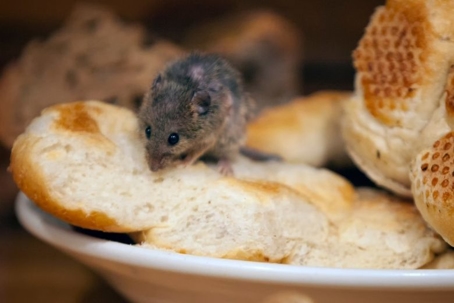Can Mice Spread Diseases?
Yes, mice can spread a variety of diseases to humans and pets, either directly or indirectly:
- Direct Transmission: mice can transmit diseases through their bites, urine, or feces.
- Indirect Transmission: Mice can carry pathogens on their fur or in their droppings that contaminate surfaces, food, or water. Mouse urine and dander are also known to trigger asthma or allergic reactions, especially in children.
- Secondary Disease Spread: Mice can also carry fleas, ticks, and mites that transmit additional diseases.
Mice are more than just a nuisance—these rodents are significant disease carriers.
What Diseases Do Mice Spread?
Mice are capable of spreading several diseases to humans, either directly through bites and contact with their urine, droppings, or saliva, or indirectly by contaminating food and surfaces:
Salmonellosis
Transmission: Contaminated food or water exposed to mouse feces.
Symptoms: Diarrhea, fever, abdominal cramps, and vomiting.
Severity: Usually self-limiting, but severe cases can occur in vulnerable populations.
E. coli Infections
Transmission: Contamination of food or surfaces by mouse feces.
Symptoms: Diarrhea, cramps, and in severe cases, hemolytic uremic syndrome (HUS).
Severity: Can be fatal; outbreaks are uncommon but serious.
Hantavirus Pulmonary Syndrome (HPS)
Transmission: Inhalation of dust contaminated with infected mouse urine, droppings, or saliva.
Symptoms: Fever, muscle aches, fatigue, and severe respiratory distress.
Severity: Can be fatal; outbreaks are rare but serious.
Leptospirosis
Transmission: Contact with water or soil contaminated by infected mouse urine.
Symptoms: Fever, chills, headache, muscle aches, vomiting, and in severe cases, liver or kidney damage.
Severity: Can be serious or even fatal if untreated.
Tularemia
Transmission: Direct contact with infected rodent tissues, bites from infected ticks or flies.
Symptoms: Fever, skin ulcers, and swollen lymph nodes.
Severity: Potentially serious if untreated.
Rat-Bite Fever (Streptobacillus moniliformis)
Transmission: Bites or scratches from infected rodents, or ingestion of contaminated food or water.
Symptoms: Fever, rash, and joint pain.
Severity: Can lead to serious complications if untreated.
Lymphocytic Choriomeningitis Virus (LCMV)
Transmission: Contact with urine, droppings, saliva, or nesting material from infected mice.
Symptoms: Fever, headache, nausea, and in severe cases, neurological complications such as meningitis or encephalitis.
Severity: Usually mild but can be dangerous for pregnant women.
Campylobacteriosis
Transmission: Contaminated food or water exposed to mouse feces.
Symptoms: Diarrhea, abdominal cramps, fever, nausea, and vomiting.
Severity: Usually self-limiting, but dehydration and complications can occur.
Plague (Yersinia pestis)
Transmission: Fleas that have fed on infected rodents.
Symptoms: Fever, swollen lymph nodes, and in severe cases, septicemia or pneumonia.
Severity: Extremely rare today, but historically deadly.
How To Stop Mice From Spreading Diseases
To stop mice from spreading diseases in a home or business, it’s crucial to combine prevention, sanitation, and control measures. Here’s how you can stop mice from spreading diseases in your home or business:
Seal Entry Points
Mice can squeeze through openings as small as a dime. Inspect your building thoroughly for:
Gaps around doors and windows
Cracks in foundations and walls
Holes around plumbing, vents, and electrical lines
Seal openings with steel wool, caulk, or metal mesh. Mice can chew through softer materials like rubber, plastic, and wood.
Maintain Sanitation
Remove food sources: Keep food in sealed containers (metal or heavy-duty plastic), clean up crumbs, and avoid leaving pet food out overnight.
Reduce water sources: Fix leaks and eliminate standing water; mice need water to survive.
Declutter: Cardboard, paper, and fabric provide nesting material. Keep storage areas organized and off the floor.
Proper Waste Management
Use tightly sealed trash bins indoors and outdoors.
Regularly remove garbage and recycling, especially food waste.
Clean spills immediately to reduce attraction.
Use Traps and Baits Safely
Snap traps are effective for small infestations.
Bait stations with rodenticides can work but must be placed out of reach of children and pets.
Always follow label instructions for safety.
Disinfect Contaminated Areas
Mice droppings, urine, and nesting material can carry pathogens. Never sweep or vacuum droppings, as this can aerosolize infectious particles.
Use rubber gloves and a disinfectant (bleach solution: 1 part bleach to 10 parts water) to clean contaminated surfaces.
Ventilate areas for 30 minutes before cleaning.
Monitor Regularly
Check for signs of mice: droppings, gnaw marks, and urine stains.
Use monitoring devices like glue boards or tracking powders in areas of high activity.
Our Professional Pest Control
For larger infestations, persistent problems, or disease-risk areas (restaurants, hospitals, warehouses), our professional extermination is recommended.
Our experts can safely apply rodenticides, seal buildings effectively, and provide ongoing monitoring.
Prevention through sealing, sanitation, and waste management is key. If mice are present, traps or professional intervention are essential. Proper cleanup and disinfection minimize disease transmission risks.

